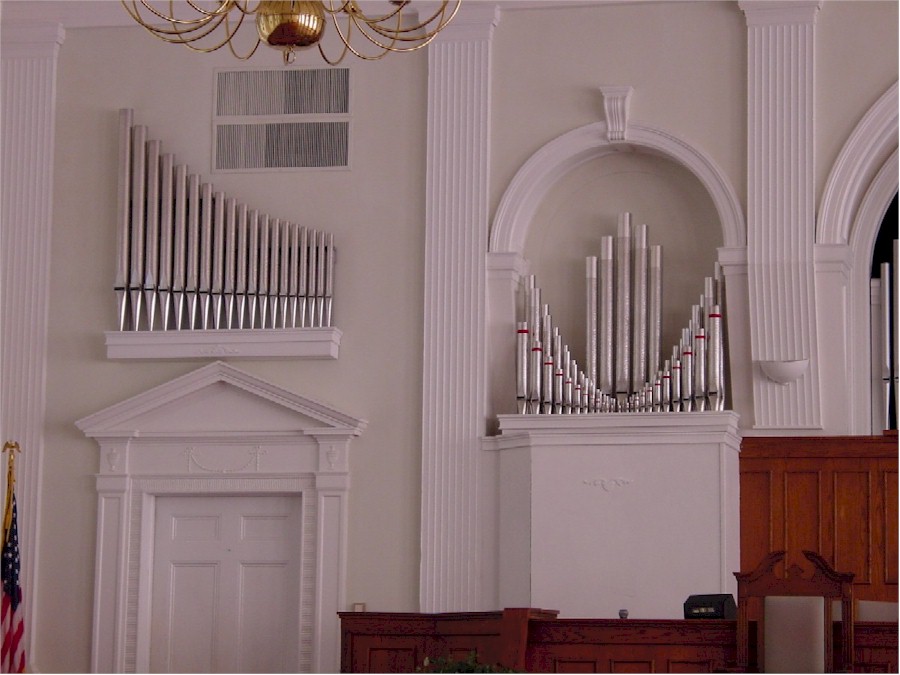ALLEN ORGAN INSTALLATIONS
First Baptist Church, Williston, South Carolina
64 Stop Three-Manual Allen Organ
Excerpted from a letter to Allen Organ:
"Just a note to say how excited we are to have our Allen pipe/digital organ installed and being used.
"In the early stages of our plans, we were or thought we wanted a full wind blown pipe organ. With some encouragement with our past music director, I reluctantly went to First Baptist North Augusta and heard and played one of your combination organs. That was all it took for me to realize the possibilities of this type instrument. That installation, until ours, became my favorite organ.
"After looking and hearing organs built by other companies, I found that yours was absolutely the best, but if it had not been for Jim Ingram and his team at Allen Organ Studios I don't know if we would have the organ today. His knowledge of the business, patience with our committee questions, and extremely wonderful personality were just a few of the factors that influenced our final decision.
"The installation was perfectly planned and carried out. Jim and his team were able to do everything we wanted and more. Not only is the sound exactly what we wanted, the visual is perfect. Our dream was made possible with your product and Jim's knowledge and professional abilities."
J. Mark Creech, Organist and Organ Committee Chairman,
First Baptist Church, Williston, South Carolina
"For centuries, worship through music has been enhanced by the sound of organ pipes. Great organs are powerful instruments also capable of whisper sounds. The design and installation of an organ that makes a quality musical statement is as unique to a church or concert hall as fingerprints are to people. The worship style, type of music to be performed, acoustical space, equipment location, power requirements, visual enhancements, tonal specifications and organ controls are but a few considerations in the design, construction and installation of and organ.
Society has somewhat rapidly grown just in my lifetime from the days of horse and buggy and T-Models to space age technology. The organ is no exception to these growth trends. In the late 1960's, the Allen Organ Company of Macungie, Pennsylvania, developed and patented the world's first musical computer. This computer was capable of storing harmonics (sounds) of organ pipes within its memory banks similar to your 1970's Allen. As computer memory and Allen technology has developed over the past 35 years, the organ you hear today employs Allen digital technology producing pipe organ sounds without the pipes. Light-years ahead in digital development, this instrument performs hundreds of thousands of calculations, almost instantly, for the organist to play just as he would actual wind blown pipes, but at a substantially lower cost. It is easy to understand today why Allen provides churches more versatile and larger instruments at a much lower cost than ever before possible.
Quality pipe organs still remain wonderful instruments to listen to and to perform on! However, the initial cost is often prohibitive for churches and schools in today's economy. While most of us find ways to achieve our 'priorities' in life, the advancements in the music industry from Allen have provided congregations a way to afford organs built from the best of both worlds.
This organ contains 67 digital ranks and 3 wind blown pipe ranks. A rank is simply defined as one set of pipes/tones containing all the notes/pitches of an identical sound. (Ex: all the notes of a Clarinet, Flute, Trumpet, etc.) This organ has pipes the size of a pencil that makes high pitch sounds - above the hearing of some - and low pitch sounds that shake the floor and move the spirit. Low pitch pipes (32 feet long) and sub-pitch tones give the organ 'feeling' and give it the largest tonal range of any musical instrument!
The pipes you see on each side of the choir loft are part of the Great Division of the organ. You do not see taller and larger bass pipes behind in the center organ chamber. The visual aspect of organ design is also important to a worship experience. The center pipes behind the baptistery are from an original pipe organ installed in the early 1900's. There were removed and fully restored for installation with the new organ. Organ pipes that do not sound but 'play' a vital visual role are called façade pipes. They also often serve to cover chamber openings where other pipes are located as well as speaker systems of digital organs. The organ blower, associated chests and wind reservoirs are located in the main center organ chamber. The front Chandeliers house special speakers for presence of the organ in the room. They are located in small chambers above the decorative plaster ceiling openings."
On a personal note, Thank You for allowing us to participate in your worship experiences each week. Working with Mark, Bob, Dick and many others to make this project extremely successful has been a true pleasure. I look forward to a continued friendship and serving your congregation for many years to come."
James W. Ingram, Jr.

